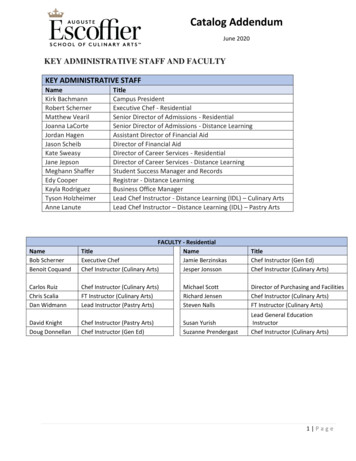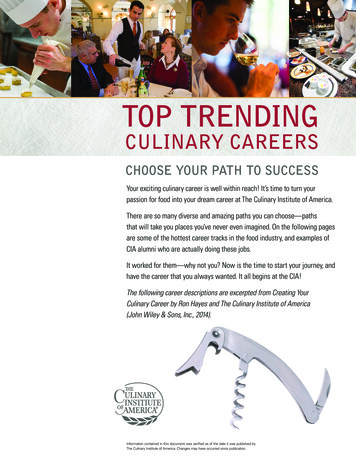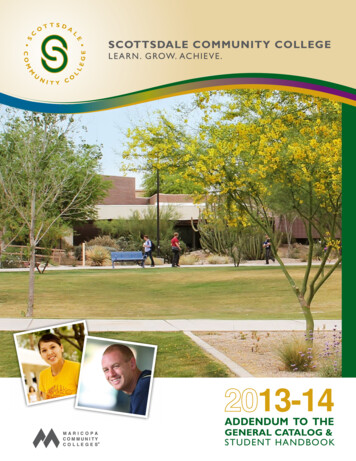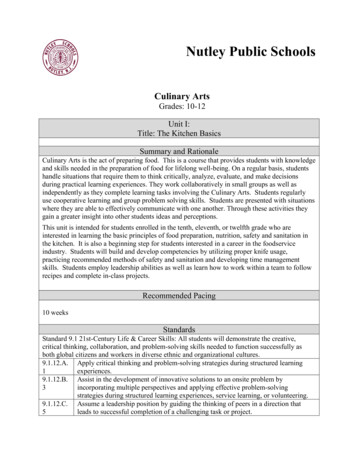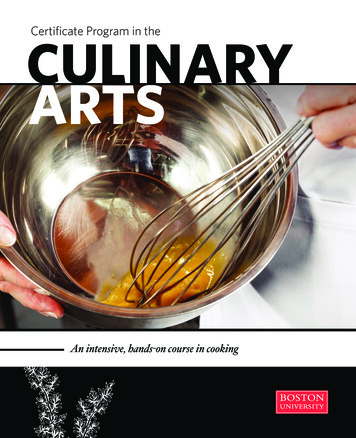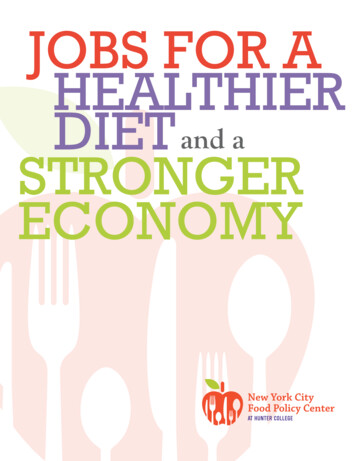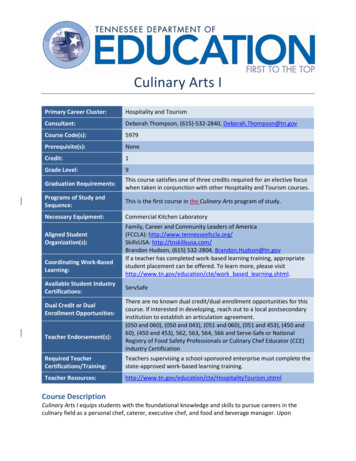
Transcription
Culinary Arts IPrimary Career Cluster:Hospitality and TourismConsultant:Deborah Thompson, (615)-532-2840, Deborah.Thompson@tn.govCourse Code(s):5979Prerequisite(s):NoneCredit:1Grade Level:9Graduation Requirements:This course satisfies one of three credits required for an elective focuswhen taken in conjunction with other Hospitality and Tourism courses.Programs of Study andSequence:This is the first course in the Culinary Arts program of study.Necessary Equipment:Commercial Kitchen LaboratoryAligned StudentOrganization(s):Coordinating Work-BasedLearning:Available Student IndustryCertifications:Dual Credit or DualEnrollment Opportunities:Teacher Endorsement(s):Family, Career and Community Leaders of America(FCCLA): http://www.tennesseefccla.org/SkillsUSA: http://tnskillsusa.com/Brandon Hudson, (615) 532-2804, Brandon.Hudson@tn.govIf a teacher has completed work-based learning training, appropriatestudent placement can be offered. To learn more, please visithttp://www.tn.gov/education/cte/work based learning.shtml.ServSafeThere are no known dual credit/dual enrollment opportunities for thiscourse. If interested in developing, reach out to a local postsecondaryinstitution to establish an articulation agreement.(050 and 060), (050 and 043), (051 and 060), (051 and 453), (450 and60), (450 and 453), 562, 563, 564, 566 and Serve-Safe or NationalRegistry of Food Safety Professionals or Culinary Chef Educator (CCE)Industry CertificationRequired TeacherCertifications/Training:Teachers supervising a school-sponsored enterprise must complete thestate-approved work-based learning training.Teacher ityTourism.shtmlCourse DescriptionCulinary Arts I equips students with the foundational knowledge and skills to pursue careers in theculinary field as a personal chef, caterer, executive chef, and food and beverage manager. Upon
completion of this course, proficient students will have knowledge in the components of commercialkitchen safety and sanitation, history of the foodservice industry, careers, nutrition, recipe basics,proper kitchen tools and equipment, and kitchen staples. Throughout the course students will gainexperience in commercial food production and service operations, while preparing for further training atthe postsecondary level. Artifacts will be created for inclusion in a portfolio, which will continuethroughout the full sequence of courses. Standards in this course are aligned with Tennessee StateStandards for English Language Arts & Literacy in Technical Subjects.* In addition to implementing tThefollowing standards, the course should include a should be implemented throughout the course aswell as suggested 30 hours of time spent in a commercial kitchen laboratory.Program of Study ApplicationThis is the first course in the Culinary Arts program of study. For more information on the benefits andrequirements of implementing this program in full, please visit the Hospitality and Tourismwebsite: .shtml.Course StandardsSafety & Sanitation1) Synthesize research from government publications such as Food and Drug Administration (FDA)Food Codes to identify the pathogens found in foods. Create an alphabetical index of pathogens,citing the research, which illustrates the required environmental factors for transmission,symptoms, and categories. (TN Reading 1, 4; TN Writing 2, 8, 9)2) Summarize the requirements for proper disposal and storage of chemicals used in thecommercial foodservice laboratory and adhere to laboratory work requirements throughoutlaboratory work in the course. Create or update an existing binder of Material Safety DataSheets (MSDS) outlining how to work with chemicals and potential hazards. Develop a list of,and demonstrate, procedures to schedule when cleaning and sanitizing the commercialfoodservice laboratory using the proper chemicals and disposal of waste; include the list in thestudent portfolio. (TN Reading 2)3) Compile, practice, and critique safety and sanitation procedures related to handling, preparing,storing, and serving food from industry-approved technical manuals and government publishedfact sheets. Identify, and review, and demonstrate general laboratory safety proceduresincluding but not limited to prevention and control procedures of pest, insects, and rodents andpersonal hygiene expectations. Incorporate safety procedures and complete safety test with 100percent accuracy; include exam in course portfolio. (TN Reading 3)History & Influences on the Food Service Industry4) Articulate important historical events and milestones that influenced culinary practices fromancient times to the present. Create a timeline or other graphic to illustrate the major impactsof these culinary practices on the progression of various styles of cuisine, citing specific textualevidence from research. (TN Reading 1, 2, 7; TN Writing 2, 9)Page 2
5) Research the growth and development of the foodservice industry, focusing on the influence ofsignificant contributors. Craft an explanatory text to outline significant contributions and theimpact on the modern day industry. Examples of significant contributors include, but are notlimited to:a. Maire-Antoine Caremeb. Auguste Escoffierc. Catherine de Medicid. Fernand Pointe. Alexis Soyer(TN Reading 2; Writing 2, 4, 9)6) Evaluate the factors that influence the foodservice industry. Form a hypothesis about howspecific factors may impact the foodservice industry. Develop claim(s) and counterclaim(s) fairly,supplying data and text-based evidence. Influential factors may include:a. Economic climateb. Social changesc. Globalization of cuisinesd. Green technologiese. Farm to Table(TN Reading 1; TN Writing 1, 4, 6)Foodservice Careers7) Compile and analyze real-time labor market data, including economic and demographic trends,and compare with authentic vacancy announcements on local and national job boards. Use thisinformation to compare and contrast occupations by education requirements, job availability,salaries, and benefits. Outline an educational pathway to obtain the necessary level of educationand relevant certifications for a chosen occupation in the foodservice industry, review andrevise throughout the program of study. (TN Reading 2, 9; TN Writing 4, 5)8) Create an organizational diagram of the kitchen workstations in the brigade system, labelingeach workstation with its unique list of roles and responsibilities. Examine the licensing,certification, and credentialing requirements for each position. Craft an explanatory essaydescribing modern variations of the brigade system and how it enhances productivity. (TNReading 9; TN Writing 2)9) Conduct research to develop a persuasive essay on contemporary issues and challenges facingthe foodservice industry. Synthesize multiple perspectives and advance an original argument toaddress the issues. Develop claim(s) and counterclaim(s) fairly, supplying data and text-basedevidence. Contemporary issues and challenges may include but are not limited to:a. Living wageb. Labor demandsc. Customer demandsd. Technology advances impacting labor needs(TN Reading 1, 9; TN Writing 1, 7, 8, 9)10) Compare and contrast the qualities of effective and ineffective teams. Work collaboratively tocorrect and refine the actions of team members to ensure productivity. Throughout the course,Page 3
demonstrate teamwork, problem solving, and decision making skills when workingcollaboratively.Nutrition and Health Overview11) Identify, analyze, and visually represent the macro- and micro- nutrients required in the humandiet. Include the common food sources of those nutrients, their chemical properties, andfunction in the body, as well as the influence upon biological systems in reference tomaintenance and growth.a. Macro nutrients include: carbohydrates, lipids, and proteinsb. Micro nutrients include: minerals, vitamins, and water(TN Reading 1, 7; TN Writing 4)12) Differentiate between food allergies and food intolerances, and describe the body’s reaction toeach. Research the eight (8) most common food allergens. Make recommendations for foodsubstitutes and recipe modifications to avoid foods that may cause a reaction, citing specificreasoning and evidence to justify the recommendation. (TN Reading 1; Writing 4)Recipe Basics13) Examine the anatomy of a recipe identifying the key points and functions of each (name, yield,portion size, ingredients, quantity, and methods). Define common recipe terminology. Use thedefinitions to gain a proficient working understanding of terms and characteristics used in thestandardized recipes. (TN Reading 4, 5)14) Compare and contrast the components of a standardized recipe with a home recipe, citingevidence from each recipe format to support comparisons. Using proper formulas, apply thecorrect conversation factor to increase and decrease the yield according to specifications notedin recipes. (TN Reading 3)15) Follow recipes precisely, including defining and utilizing specific culinary and measurementterms as needed. Discuss ways to reduce waste in food products. (TN Reading 3, 4)Kitchen Equipment16) Identify, and describe, and effectively demonstrate the use of the hand tools and smallwaresused in commercial food preparation. Using supporting evidence from a variety of equipmentmanuals and fact sheets, create an informational guide to differentiate the functions, cleaningprocedures, storage, and examples of proper use of tools used in commercial foodservice. (TNReading 1; TN Writing 2)17) Examine various pieces of large equipment employed in commercial kitchens, includingrefrigeration units, holding units, grills and broilers, ranges and ovens. Explain the properties ofdesign and their relationship to functionality for each piece of equipment examined. Determinethe appropriate equipment needed for various tasks performed in the commercial kitchen,properly demonstrate safe use, and outline and practice proper cleaning procedures. (TNReading 1)Page 4
18) Identify, and be able to select, the appropriate measuring tools (i.e. measuring cups, pitchers,spoons, scales, and thermometers) for a variety of ingredients. Execute proper measuringrequired for ingredients for recipes in lab settings.Preparation Techniques19) Distinguish among the different types of knives (i.e. paring, serrated, slicers, utility, and chef’s)and explain their elements of construction. Identify and demonstrate the correct use,sharpening techniques, and storage options for each type of knife examined. Create a how-tographic outlining the proper safety handling techniques when using knifes in the kitchen, citingevidence. (TN Reading 1, 3, 7; TN Writing 1, 9)20) Categorize the different types of cuts by justifying how they should be used for a given recipe orpresentation. Prepare a workstation for knife work. Practice and execute the three basic knifecuts (slice, stick, and dice) using the correct safety methods. Upload either a picture or videointo the student portfolio documenting correct use. (TN Writing 6)Cooking Principles21) Using culinary resources, such as textbooks or industry magazines, compare and contrast dry,moist, and combination cooking methods in a class discussion. Create an informational artifactthat describes each method, locate and an example recipe for each, and demonstrate effectiveuse of the technique in a laboratory setting. Examples may include:a. Blanchingb. Bakingc. Grillingd. Fryinge. Poachingf. Boilingg. Broiling(TN Reading 1, 5; TN Writing 2, 4, 9)Kitchen Staples22) Create an index of basic seasonings, herbs, and spices used in professional kitchens. Researchand cite evidence from digital text resources and culinary guides that describes the sources,varied forms, and uses in professional kitchens. Asses the cost of using fresh herbs orsubstituting dried herbs without affecting the quality of the final product. Provide an example ofa recipe for which the substitution may be made successfully. (TN Reading 1, 4; TN Writing 2, 8,9)23) Distinguish the differences in form and flavor between the variety of sweeteners (i.e. sugar,molasses, honey, brown sugar, maple syrup, corn syrup, and agave nectar) from a tastetest/observation in the lab setting. Discuss common substitutions for sweeteners in recipeswithout compromising quality, citing culinary research. (TN Reading 1, 6)Page 5
24) Compare and contrast the different types of starches used in commercial kitchens and describethe physical properties of each:a. Flour (all-purpose, semolina, rice flour)b. Cornmealc. Cornstarchd. Arrowroote. Breadcrumbs (panko, dried, and fresh breadcrumbs)Create a chart that describes which starch is best suited for each function in the kitchen, citingan example dish. (TN Reading 1, 5, 6; TN Writing 2, 9)25) Research the roles of acids as ingredients in the kitchen using culinary journals and text. Form ahypothesis and design and conduct an experiment to identify the role of the acid ingredients inrelations to food preparation techniques. Summarize experiment results into an argumentmaking a claim about the impact of a selected acid ingredient on food composition. Compareresults to findings in news media and note when findings support or contradict previousexplanations or accounts. Acid ingredients may include but are not limited to vinegars, lemonjuice, and lime juice. (TN Reading 2, 3, 8, 9; TN Writing 2, 7, 8, 9)Garde MangerSalads26) Compare and contrast the different types of salads (i.e. simple, composed, and bound) and therole of the ingredients in each, citing evidence from culinary textbooks. Using print or digitalresources, discuss the qualities of simple and emulsified dressings, citing examples of each.Evaluate a salad recipe, analyzing the choice of ingredients, and any proposed modifications, orsubstitute ingredients. Draft the recipe with modification and prepare the salad. Include therecipe and a photo of the salad in the student portfolio. (TN Reading 2, 9; TN Writing 2, 4, 9)Sandwiches27) Categorize the different types of sandwiches, discussing the roles of ingredients, assemblymethods, and attributes. Create a recipe for a cold sandwich that reflects the local taste of yourregion and culinary trends. The recipe should reflect the use of local products, taste ofconsumers, and connections to the region. Craft an accompanying explanatory text discussingthe use of the local products, connection to the region, and descriptions of the sandwich. (TNReading 2, 9; TN Writing 2, 8, 9)The following artifacts will reside in the student portfolio: Index of pathogens List of procedures for cleaning and sanitizing Safety Exam History events and milestones timeline Contributor paper Educational Pathway Assignment Organizational diagram of work sessions Persuasive contemporary issues essayPage 6
Allergy Substitution RecommendationKnife how-to-graphicDocumentation of knife cutsCooking Principle artifactSeasoning IndexCommon SubstitutionStarch chartSandwich RecipeSalad RecipeStandards Alignment Notes*References to other standards include: TN Reading: Tennessee State Standards for English Language Arts & Literacy in History/SocialStudies, Science, and Technical Subjects; Reading Standards for Literacy in Science and TechnicalSubjects 6-12; Grades 9-10 Students (page 62).o Note: While not directly aligned to one specific standard, students that are engaging inactivities outlined above should be able to also demonstrate fluency in Standard 10 atthe conclusion of the course. TN Writing: Tennessee State Standards for English Language Arts & Literacy in History/SocialStudies, Science, and Technical Subjects; Writing Standards for Literacy in History/Social Studies,Science, and Technical Subjects 6-12; Grades 9-10 Students (pages 64-66).o Note: While not directly aligned to one specific standard, students that are engaging inactivities outlined above should be able to also demonstrate fluency in Standards 3, 5and 10 at the conclusion of the course. P21: Partnership for 21st Century Skills Framework for 21st Century Learningo Note: While not all standards are specifically aligned, teachers will find the frameworkhelpful for setting expectations for student behavior in their classroom and practicingspecific career readiness skills.Page 7
Culinary Arts IIPrimary Career Cluster:Hospitality and TourismConsultant:Deborah Thompson, (615)-532-2840, Deborah.Thompson@tn.govCourse Code(s):5980Prerequisite(s):Culinary Arts ICredit:1Grade Level:10Graduation Requirements:This course satisfies one credit of three credits required for an electivefocus when taken in conjunction with other Hospitality and Tourismcourses.Programs of Study andSequence:This is the second course in the Culinary Arts program of study.Necessary Equipment:Commercial Kitchen LaboratoryAligned StudentOrganization(s):Coordinating Work-BasedLearning:Available Student IndustryCertifications:Dual Credit or DualEnrollment Opportunities:Teacher Endorsement(s):Family, Career and Community Leaders of America(FCCLA): http://www.tennesseefccla.org/SkillsUSA: http://tnskillsusa.com/Brandon Hudson, (615) 532-2804, Brandon.Hudson@tn.govIf a teacher has completed work-based learning training, appropriatestudent placement can be offered. To learn more, please visithttp://www.tn.gov/education/cte/work based learning.shtml.ServSafeThere are no known dual credit/dual enrollment opportunities for thiscourse. If interested in developing, reach out to a local postsecondaryinstitution to establish an articulation agreement.(050 and 060), (050 and 043), (051 and 060), (051 and 453), (450 and60), (450 and 453), 562, 563, 564, 566 and Serve-Safe or NationalRegistry of Food Safety Professionals or Culinary Chef Educator (CCE)Industry CertificationRequired TeacherCertifications/Training:Teachers supervising a school-sponsored enterprise must complete thestate-approved work-based learning training.Teacher ityTourism.shtml.
Course DescriptionCulinary Arts II is an applied-knowledge course to prepare students for careers in the culinary field as apersonal chef, caterer, executive chef, and food and beverage manager. Upon completion of this course,proficient students will have an understating of commercial kitchen safety and sanitation, menuplanning, food presentation, purchasing and inventory, preparation skills, cooking principles, and foodpreparation. Students will gain experience in commercial food production and service operations, whilepreparing for further training at the postsecondary level. Artifacts will be created for inclusion in aportfolio, which will continue throughout the full sequence of courses. Standards in this course arealigned with Tennessee State Standards for English Language Arts & Literacy in Technical Subjects andTennessee State Standards in Mathematics.* In addition to implementing the following standards, thecourse should include a suggested 30 hours spent in a commercial kitchen laboratory.Program of Study ApplicationThis is the second course in the Culinary Arts program of study. For more information on the benefitsand requirements of implementing this program in full, please visit the Hospitality and Tourismwebsite: .shtml.Course StandardsSafety & Sanitation1) Summarize the different ways that cross-contamination can occur in the kitchen, citing sourcesfrom the U.S. Department of Health and Human Services or other federal guidelines. Write ascript and Ccreate a video or public service announcement explaining how to prevent crosscontamination in the kitchen. (TN Reading 1, 6; TN Writing 6)2) Identify the steps for sanitizing food-contact surfaces in the kitchen, citing evidence fromtextbooks, regulations, or similar collections of best practices. Compare and contrast thedifferent types of sanitizing (i.e., heat and chemical) and distinguish when each type should beused. In small groups, inspect the classroom kitchen using the Food Service EstablishmentInspection Report from the Tennessee Department of Health. (TN Reading 3, 9)3) Compile, practice, and critique safety and sanitation procedures related to handling, preparing,storing, and serving food from industry-approved technical manuals and government publishedfact sheets. Identify, and review, and demonstrate common laboratory safety procedures,including but not limited to prevention and control procedures and personal hygieneexpectations. Incorporate safety procedures and complete safety test with 100 percentaccuracy; include exam in the student portfolio. (TN Reading 3)Menu Planning4) Compare and contrast the main types of menus (market menu, a la carte, static menu, cyclemenu, and table d’hote) and synthesize basic planning principles for a variety of differentrestaurant menus. Apply menu planning principles to create a menu for an assigned concept,following recommendations in state truth-in-menu guidelines, or in the Nutrition Labeling andEducation Act (NLEA). Incorporate appropriate service style, cuisine, and atmosphere whenPage 2
crafting the menu. In small groups, review the menu of peers to strengthen their overall qualitythrough revising and editing. (TN Reading 2, 9; TN Writing 2, 4, 5)5) Analyze the elements that affect food cost and labor cost in foodservice operations, citingexamples from real companies. Demonstrate working knowledge of costing a recipe andpredicting labor cost percentages. Craft an explanatory text illustrating the impact of such costs.Formulas include:a. Calculating Per Pound Unit Cost (Price per Case Number of pounds in case PerPound)b. Calculating Per Ounce Unit Cost (Price per Pound 16 ounces Cost Per Ounce)c. Calculating Per Piece Unit Cost (Cost Number of Pieces Cost per Piece)d. Calculating Total Cost (Number of Units x Unit Price Total Cost)e. Calculating Edible Portion (EP) Price (As Purchased [AP] Cost Yield Percentage EdiblePortion [EP] Price)f. Calculating Yield Percentage (Edible Portion [EP] As Purchased [AP] x 100 YieldPercentage)g. Calculating Labor Cost (Labor Cost Food Sales Labor Cost Percentage)(TN Reading 1, 7; TN Writing 2, 4; TN Math N-Q)6) Evaluate the different methods and formulas (going rate, prix fixe, markup, and food costpercentage) that foodservice operations usetilize to calculate the price of dishes. Select thecorrect formulas to calculate the menu price for an assigned dish. Formulas include but are notlimited to:a. Markup (Food Cost Markup Menu Price)b. Food Cost Percentage (Food Cost per Portion Standard Food Cost Percentage MenuPrice)(TN Math N-Q)Presentation7) Research and describe the plating principles that guide platter and buffet presentation,including color, height, focal point, temperature, and proportion. Apply plating principlesthroughout the course remaining sequence of courses to design attractive platter and platepresentations. (TN Reading 1;; TN Writing 2, 4; TN Math N-Q)8) From recipe research, create a list of commonly used edible garnishes. Create a cheat sheet ofprinciples to remember when deciding which garnish should accompany a given dish. Examplesof principles include dish temperature, functional appearance, and using garnishes sparingly.(TN Reading 1; TN Writing 7, 7)Purchasing, Receiving, and Inventory & Storage9) List the factors (i.e., environmental, economic, social, and/or government regulations) thatinfluence food prices and quality, drawing on diverse resources and perspectives includingrecent news media. Research the purchasing methods (i.e., bids, purchase orders, requisition,and sales quotes) that foodservice operations use to order supplies. Craft an explanatory textoutlining the pros and cons of each, analyzing how such methods are used to manage foodcosts. (TN Reading 2, 8; TN Writing 2, 9)Page 3
10) Summarize the requirements for proper receiving and storage of food products from the U.S.Department of Agriculture and other culinary resources. Develop a brief manual on properprocedures for receiving and storage of food products, including both raw and prepared foods,justifying recommendations specific to temperature and product rotation. (TN Reading 1, 3, 5;TN Writing 4, 6, 8)11) Investigate technology advances in foodservice management softwares, including inventorydatabases and employee time keeping systems. Create a basic inventory system for easyreference of par stock, recipes, ordering, and receiving of items; employ consistentdocumentationing procedures using purchase orders and related templates. (TN Reading 2, 6;TN Writing 6)Preparation Skills12) Compare and contrast the size and shape of different cuts used in commercial kitchens. Practiceperforming different cuts using the correct steps corresponding to each. Cuts include but are notlimited to:a. Brunosieb. Chiffonadec. Diced. Juliennee. Mincef. RondelleEither record a video or take a picture to demonstrate mastery of techniques to place in thestudent portfolio. Execute proper safety and cutting techniques when using knives in the lab.(TN Reading 3)Cooking Principles13) Define the three classifications of cooking methods (combination, dry, and moist), citing anexample of each. Discuss how heat is transferred by conduction, convection, and radiation,incorporating evidence from kitchen equipment manuals or textbooks. Compare the uses ofthese techniques in the kitchen laboratory to their explanations in texts. (TN Reading 2, 5, 9)14) Select three pieces of a food (i.e., a piece of chicken, apple, or potato). Form a hypothesisregarding what happens when that food is overcooked or undercooked using a certain cookingmethod. Conduct an experiment to test the hypothesis. Report results in an explanatory textoutlining the physical change in appearance, flavor, texture, weight, and moisture of the food.(TN Reading 3, 9; TN Writing 2)Food PreparationFor each of the following food types, prepare a “cheat sheet” to include as part of a food preparationindex in the student portfolio. The index will address forms, preparation methods, classification andgrading processes, receiving and storage practices, and a sample standardized recipe and photograph ofthe prepared dish. For each entry, draw on relevant culinary research and guidelines from regulatoryagencies and organizations to support information included in the index.Page 4
Fruits15) Research the classification of fruits and cite an example of a fruit from each classificationcommonly used in commercial foodservice, including those often mistaken as vegetables.Referring to research from the U.S. Department of Agriculture (USDA), categorize the gradesthat fruit may be purchased in, note its primary growing season, and explain the different formsavailable to consumers. (TN Reading 1, 4; TN Writing 9)16) From recipes, sSummarize from recipes the steps to prepare and/or cook fruits when preparingdishes, displays, and garnishes. Draw on basic chemistry principles to explain the process ofoxidation and the importance of acidulation when preparing certain fruit dishes. Select a fruitrecipe and modify the recipe to incorporate fruits that are currently in season. (TN Reading 3, 7;TN Writing 4, 9)17) Write a research paper or conduct a research project on a current culinary topic or issueaffecting the foodservice industry, using appropriate digital search resources and academicwriting. Topics may include but are not limited to:a. Organic fruits versus nonorganic fruitsb. Technologies for preserving fruits (canned, frozen, and dried)c. Buying locald. Traceability of produce (i.e., carbon footprint)e. Acidulating fruits(TN Reading 2, 6; TN Writing 7)Vegetables18) Distinguish among the most commonly used vegetables in commercial foodservice. For eachvegetable examined, describe its anatomy and use based on information gathered in culinarytextbooks. Evaluate the quality factors when selecting vegetables, including growing seasonsand regions, available forms of purchase, and vegetable gradings, citing relevant research fromgovernment authorities where appropriate. Compile a collection of standardized recipes thatdemonstrates the diverse cooking methods employed in foodservice settings. (TN Reading 1, 4;TN Writing 6)19) Summarize various moist-heat and dry-heat cooking methods from the collection ofstandardized recipes gathered in standard 18. Research the principles of vegetable cookeryusing culinary journals and magazines to identify the factors that affect the flavor, texture, colorand retention of nutrients in cooked vegetables. Select the best cooking method for a chosenvegetable, justifying the selection based on the evidence. (TN Reading 1, 4; TN Writing 2, 9)20) Form a hypothesis and design and conduct an experiment to determine the role of acid andalkaline solutions in a vegetable’s color during the cooking process. Summarize experimentresults into an argument making a claim about the impact of a selected solution ingredient onvegetable composition. Compare results to findings in news media and culinary journals, andnote when findings support or contradict previous explanations or accounts. (TN Reading 3, 4,95; TN Writing 12, 7, 9)Page 5
Stocks, Soups, & Sauces21) Research and summarize the roles of a variety of ingredients in the production of stocks (i.e.,white stock, brown stock, broth/bouillon, vegetable stock, and fish stock). Compare thecharacteristics of the stocks, cooking times, and ingredients’ contributions to the flavor profile.Create a list of steps to execute when making stocks and bases. Demonstrate the skill of makingstock and evaluating the quality of the finished product by following the multistep procedurecreated above. (TN Reading 1, 3, 4; TN Writing 2)22) Compare and contrast the types of soups (i.e., clear soups, thick soups, and specialty soups).Follow and continually modify soup recipes to create a variety of soups for a given menu.
Culinary Arts I . Course Description Culinary Arts I equips students with the foundational knowledge and skills to pursue careers in the culinary field as a personal chef, caterer, executive chef, and food and beverage manager. Upon Primary Career Cluster: Hospitality and Tourism Consultant: Deborah Thompson, (615)-532-2840, Deborah.Thompson@tn.gov
